Abstract
Electron spin resonance (ESR) spin trapping was utilized to investigate the generation of free radicals from oxidation of sodium sulfite, nickel(II) sulfite, and nickel subsulfide (Ni3S2) by ambient oxygen or H2O2 at pH 7.4. The spin trap used was 5,5-dimethyl-1-pyrroline-N-oxide (DMPO). Under ambient oxygen, a solution of sodium sulfite alone generated predominantly sulfur trioxide anion radical (.SO3-) due to the autoxidation of sulfite. Addition of nickel(II) chloride [Ni(II)] enhanced the .SO3- yield about 4-fold. Incubation of sulfite with Ni(II) in the presence of chelators such as tetraglycine, histidine, beta-alanyl-3-methyl-L-histidine (anserine), beta--L-histidine (carnosine), gamma-aminobutyryl-L-histidine (homocarnosine), glutathione, and penicillamine did not have any significant effect on that enhancement. In contrast, albumin, and especially glycylglycylhistidine (GlyGlyHis), augmented the enhancing effect of Ni(II) by factors of 1.4 and 4, respectively. Computer simulation analysis of the spin-adduct spectrum and formate scavenging experiment showed that the mixture of sodium sulfite, Ni(II), and GlyGlyHis generated both hydroxyl (.OH) radical and .SO3- radical, in the ratio of approximately 1:2. The free-radical spin adduct intensity reached its saturation level in about 5 min. The yield of the radical adducts could be slightly reduced by deferoxamine and very strongly reduced by diethylenetriaminepentaacetic acid (DTPA). Aqueous suspensions of sparingly soluble nickel(II) sulfite in the presence of air and GlyGlyHis generated surface-located .SO3- and .OH radicals. The same radicals were generated in Ni3S2 suspension in the presence of GlyGlyHis and H2O2, indicating sulfite production by oxidation of the sulfide moiety of this compound.(ABSTRACT TRUNCATED AT 250 WORDS)
Full text
PDF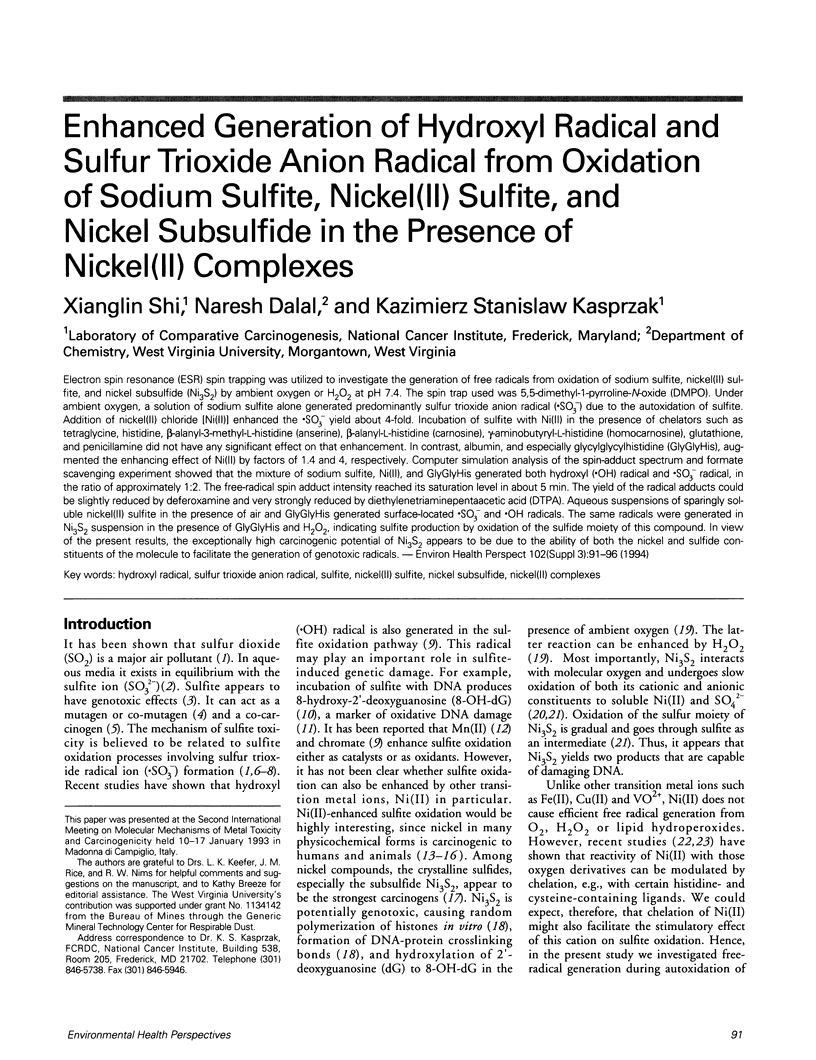
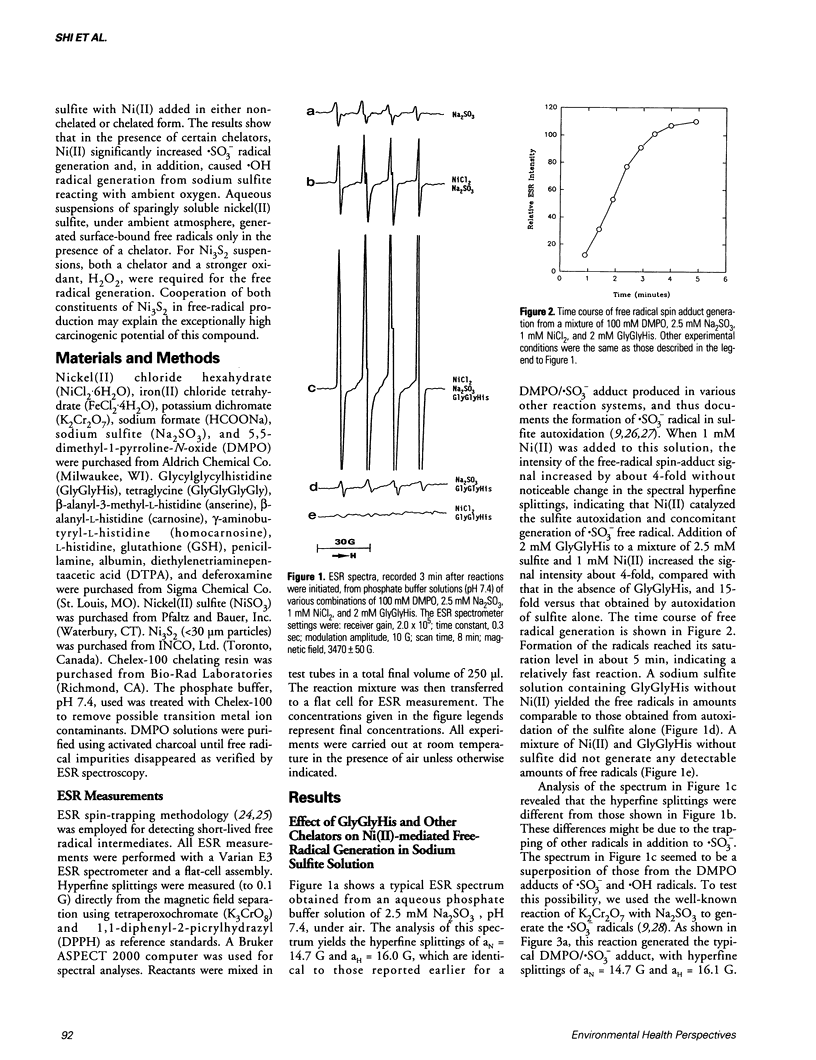
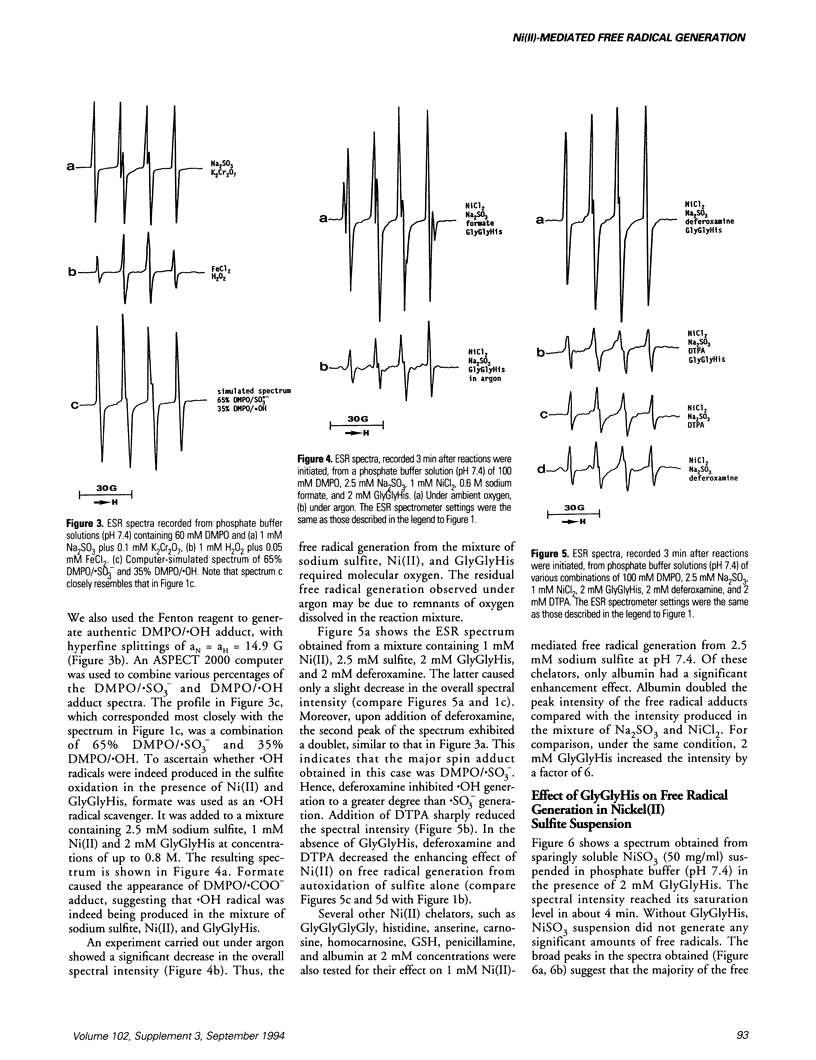
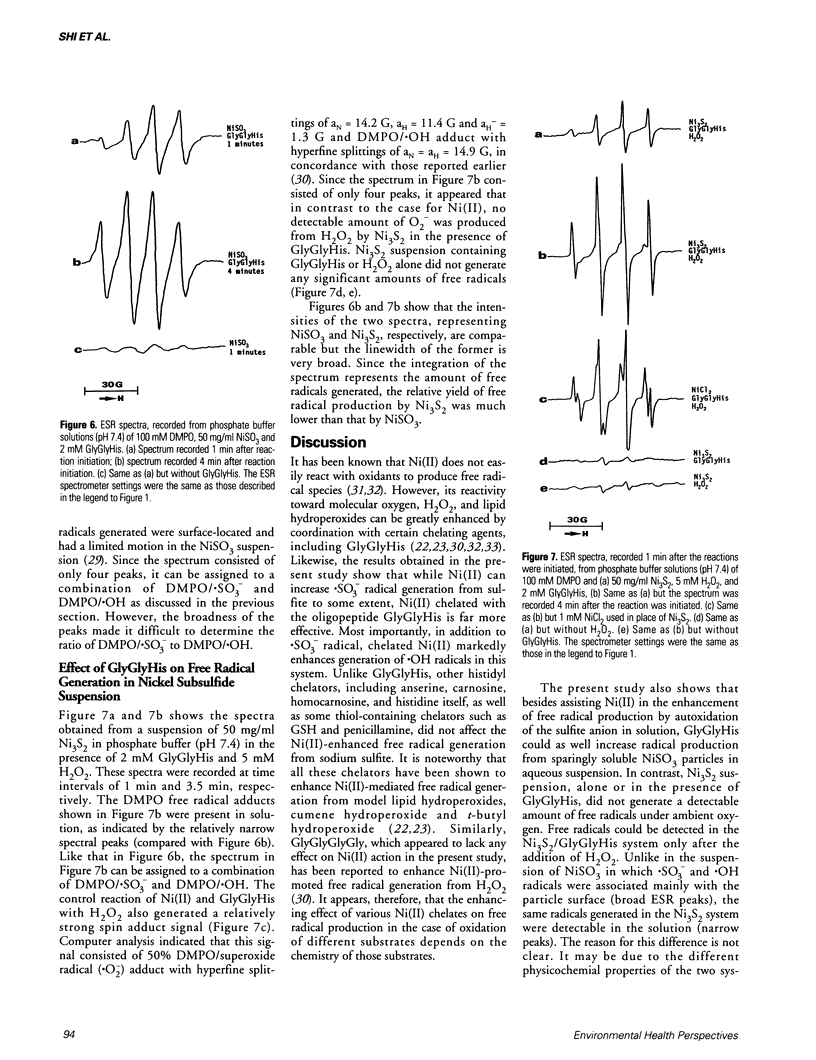
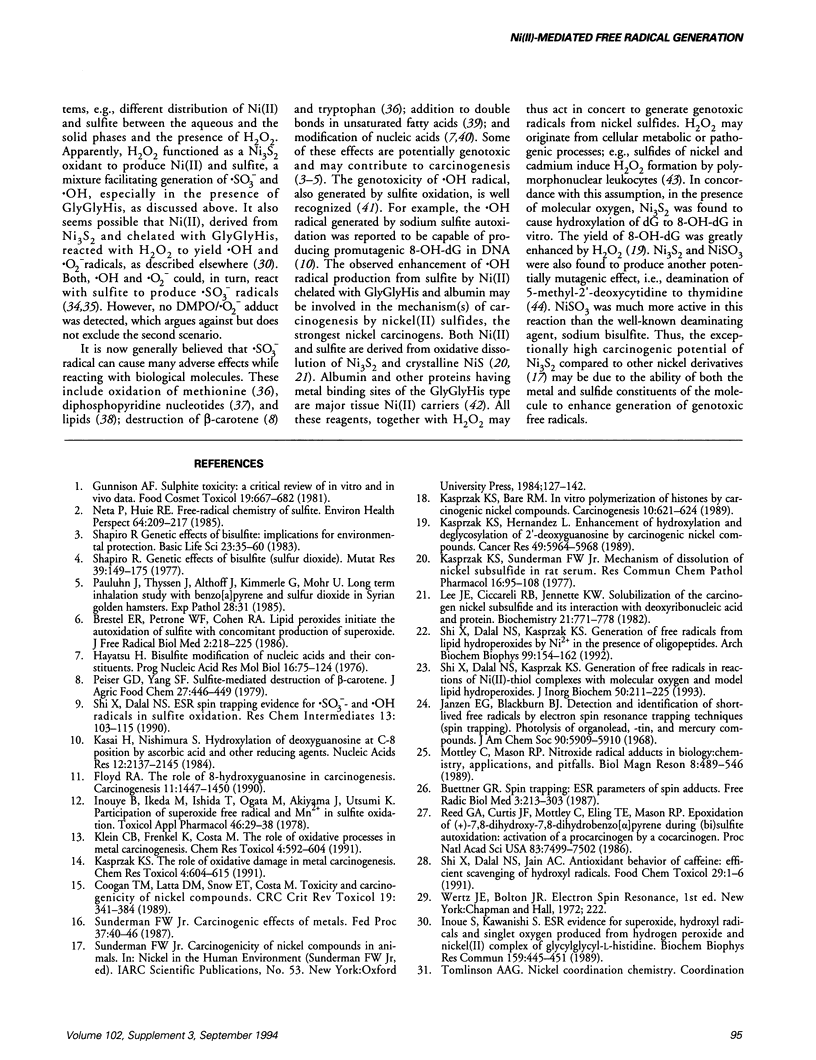

Selected References
These references are in PubMed. This may not be the complete list of references from this article.
- Brestel E. P., Petrone W. F., Cohen R. A. Lipid hydroperoxides initiate the autoxidation of sulfite with concomitant production of superoxide. J Free Radic Biol Med. 1986;2(3):219–225. doi: 10.1016/s0748-5514(86)80073-3. [DOI] [PubMed] [Google Scholar]
- Buettner G. R. Spin trapping: ESR parameters of spin adducts. Free Radic Biol Med. 1987;3(4):259–303. doi: 10.1016/s0891-5849(87)80033-3. [DOI] [PubMed] [Google Scholar]
- Coogan T. P., Latta D. M., Snow E. T., Costa M. Toxicity and carcinogenicity of nickel compounds. Crit Rev Toxicol. 1989;19(4):341–384. doi: 10.3109/10408448909029327. [DOI] [PubMed] [Google Scholar]
- Floyd R. A. The role of 8-hydroxyguanine in carcinogenesis. Carcinogenesis. 1990 Sep;11(9):1447–1450. doi: 10.1093/carcin/11.9.1447. [DOI] [PubMed] [Google Scholar]
- Gunnison A. F. Sulphite toxicity: a critical review of in vitro and in vivo data. Food Cosmet Toxicol. 1981 Oct;19(5):667–682. doi: 10.1016/0015-6264(81)90519-8. [DOI] [PubMed] [Google Scholar]
- Halliwell B., Aruoma O. I. DNA damage by oxygen-derived species. Its mechanism and measurement in mammalian systems. FEBS Lett. 1991 Apr 9;281(1-2):9–19. doi: 10.1016/0014-5793(91)80347-6. [DOI] [PubMed] [Google Scholar]
- Hayatsu H. Bisulfite modification of nucleic acids and their constituents. Prog Nucleic Acid Res Mol Biol. 1976;16:75–124. doi: 10.1016/s0079-6603(08)60756-4. [DOI] [PubMed] [Google Scholar]
- Hayatsu H., Miller R. C., Jr The cleavage of DNA by the oxygen-dependent reaction of bisulfite. Biochem Biophys Res Commun. 1972 Jan 14;46(1):120–124. doi: 10.1016/0006-291x(72)90638-9. [DOI] [PubMed] [Google Scholar]
- Inoue S., Kawanishi S. ESR evidence for superoxide, hydroxyl radicals and singlet oxygen produced from hydrogen peroxide and nickel(II) complex of glycylglycyl-L-histidine. Biochem Biophys Res Commun. 1989 Mar 15;159(2):445–451. doi: 10.1016/0006-291x(89)90012-0. [DOI] [PubMed] [Google Scholar]
- Inouye B., Ikeda M., Ishida T., Ogata M., Akiyama J., Utsumi K. Participation of superoxide free radical and Mn2+ in sulfite oxidation. Toxicol Appl Pharmacol. 1978 Oct;46(1):29–38. doi: 10.1016/0041-008x(78)90134-5. [DOI] [PubMed] [Google Scholar]
- KLEBANOFF S. J. The sulfite-activated oxidation of reduced pyridine nucleotides by peroxidase. Biochim Biophys Acta. 1961 Mar 18;48:93–103. doi: 10.1016/0006-3002(61)90519-4. [DOI] [PubMed] [Google Scholar]
- Kasai H., Nishimura S. Hydroxylation of deoxyguanosine at the C-8 position by ascorbic acid and other reducing agents. Nucleic Acids Res. 1984 Feb 24;12(4):2137–2145. doi: 10.1093/nar/12.4.2137. [DOI] [PMC free article] [PubMed] [Google Scholar]
- Kasprzak K. S., Bare R. M. In vitro polymerization of histones by carcinogenic nickel compounds. Carcinogenesis. 1989 Mar;10(3):621–624. doi: 10.1093/carcin/10.3.621. [DOI] [PubMed] [Google Scholar]
- Kasprzak K. S., Hernandez L. Enhancement of hydroxylation and deglycosylation of 2'-deoxyguanosine by carcinogenic nickel compounds. Cancer Res. 1989 Nov 1;49(21):5964–5968. [PubMed] [Google Scholar]
- Kasprzak K. S., Sunderman F. W., Jr Mechanisms of dissolution of nickel subsulfide in rat serum. Res Commun Chem Pathol Pharmacol. 1977 Jan;16(1):95–108. [PubMed] [Google Scholar]
- Kasprzak K. S. The role of oxidative damage in metal carcinogenicity. Chem Res Toxicol. 1991 Nov-Dec;4(6):604–615. doi: 10.1021/tx00024a002. [DOI] [PubMed] [Google Scholar]
- Klein C. B., Frenkel K., Costa M. The role of oxidative processes in metal carcinogenesis. Chem Res Toxicol. 1991 Nov-Dec;4(6):592–604. doi: 10.1021/tx00024a001. [DOI] [PubMed] [Google Scholar]
- Lee J. E., Ciccarelli R. B., Jennette K. W. Solubilization of the carcinogen nickel subsulfide and its interaction with deoxyribonucleic acid and protein. Biochemistry. 1982 Feb 16;21(4):771–778. doi: 10.1021/bi00533a030. [DOI] [PubMed] [Google Scholar]
- Neta P., Huie R. E. Free-radical chemistry of sulfite. Environ Health Perspect. 1985 Dec;64:209–217. doi: 10.1289/ehp.8564209. [DOI] [PMC free article] [PubMed] [Google Scholar]
- Pauluhn J., Thyssen J., Althoff J., Kimmerle G., Mohr U. Long-term inhalation study with benzo(a)pyrene and SO2 in Syrian golden hamsters. Exp Pathol. 1985;28(1):31–31. doi: 10.1016/s0232-1513(85)80029-3. [DOI] [PubMed] [Google Scholar]
- Reed G. A., Curtis J. F., Mottley C., Eling T. E., Mason R. P. Epoxidation of (+/-)-7,8-dihydroxy-7,8-dihydrobenzo[a]pyrene during (bi)sulfite autoxidation: activation of a procarcinogen by a cocarcinogen. Proc Natl Acad Sci U S A. 1986 Oct;83(19):7499–7502. doi: 10.1073/pnas.83.19.7499. [DOI] [PMC free article] [PubMed] [Google Scholar]
- Shapiro R. Genetic effects of bisulfite (sulfur dioxide). Mutat Res. 1977;39(2):149–175. doi: 10.1016/0165-1110(77)90020-3. [DOI] [PubMed] [Google Scholar]
- Shapiro R. Genetic effects of bisulfite: implications for environmental protection. Basic Life Sci. 1983;23:35–60. doi: 10.1007/978-1-4684-4382-0_2. [DOI] [PubMed] [Google Scholar]
- Shi X., Dalal N. S., Jain A. C. Antioxidant behaviour of caffeine: efficient scavenging of hydroxyl radicals. Food Chem Toxicol. 1991 Jan;29(1):1–6. doi: 10.1016/0278-6915(91)90056-d. [DOI] [PubMed] [Google Scholar]
- Shi X., Dalal N. S., Kasprzak K. S. Generation of free radicals from lipid hydroperoxides by Ni2+ in the presence of oligopeptides. Arch Biochem Biophys. 1992 Nov 15;299(1):154–162. doi: 10.1016/0003-9861(92)90257-w. [DOI] [PubMed] [Google Scholar]
- Shi X., Dalal N. S., Kasprzak K. S. Generation of free radicals in reactions of Ni(II)-thiol complexes with molecular oxygen and model lipid hydroperoxides. J Inorg Biochem. 1993 May 15;50(3):211–225. doi: 10.1016/0162-0134(93)80026-6. [DOI] [PubMed] [Google Scholar]
- Southerland W. M., Akogyeram C. O., Toghrol F., Sloan L., Scherrer R. Interaction of bisulfite with unsaturated fatty acids. J Toxicol Environ Health. 1982 Sep;10(3):479–491. doi: 10.1080/15287398209530270. [DOI] [PubMed] [Google Scholar]
- Sunderman F. W., Jr Carcinogenic effects of metals. Fed Proc. 1978 Jan;37(1):40–46. [PubMed] [Google Scholar]
- Sunderman F. W., Jr Carcinogenicity of nickel compounds in animals. IARC Sci Publ. 1984;(53):127–142. [PubMed] [Google Scholar]
- Vediaev F. P. Dinamika vegetativnykh komponentov slozhnykh dvigatel'nykh refleksov retikuliarnogo proiskhozhdeniia. Zh Vyssh Nerv Deiat Im I P Pavlova. 1967 Nov-Dec;17(6):1034–1042. [PubMed] [Google Scholar]
- Yang S. F. Sulfoxide formation from methionine or its sulfide analogs during aerobic oxidation of sulfite. Biochemistry. 1970 Dec 8;9(25):5008–5014. doi: 10.1021/bi00827a027. [DOI] [PubMed] [Google Scholar]
- Zhong Z. J., Troll W., Koenig K. L., Frenkel K. Carcinogenic sulfide salts of nickel and cadmium induce H2O2 formation by human polymorphonuclear leukocytes. Cancer Res. 1990 Dec 1;50(23):7564–7570. [PubMed] [Google Scholar]


